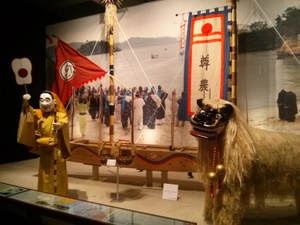Difference between revisions of "Nirai kanai"
(Created page with "right|thumb|300px|[[Miruku coming ashore from ''nirai kanai'' during a festival, bringing ''yugafu'' (good fortune), as represented in a museum display...") |
|||
| (One intermediate revision by the same user not shown) | |||
| Line 1: | Line 1: | ||
[[File:Miruku.jpg|right|thumb|300px|[[Miruku]] coming ashore from ''nirai kanai'' during a festival, bringing ''[[yugafu]]'' (good fortune), as represented in a museum display at the [[National Museum of Japanese History]]. Also seen here are a ''[[shisa]]'' (lion) and ''[[hari]]'' (dragon boat), welcoming the deity.]] | [[File:Miruku.jpg|right|thumb|300px|[[Miruku]] coming ashore from ''nirai kanai'' during a festival, bringing ''[[yugafu]]'' (good fortune), as represented in a museum display at the [[National Museum of Japanese History]]. Also seen here are a ''[[shisa]]'' (lion) and ''[[hari]]'' (dragon boat), welcoming the deity.]] | ||
*''Other Names'': ぎれーかねー ''(giree kanee)'' | *''Other Names'': ぎれーかねー ''(giree kanee)'' | ||
| − | *''Japanese'': ニライカナイ ''(nirai kanai)'' | + | *''Japanese'': ニライカナイ ''(nirai kanai)''<ref>Some sources suggest that the term ''nirai kanai'' is derived from or related to 根の屋・金屋 (Standard Japanese: ''ne no ya, kanaya''), meaning very roughly a house at the root, source, or origin, a golden house. Sakima Toshikatsu 崎間敏勝, ''Shurijô to Sanshin'' 首里城と三絃, Yonabaru, Okinawa: Ryûkyû bunka rekishi kenkyûjo (2009), 168.</ref> |
''Nirai kanai'' is a legendary paradise prominent in [[Ryukyuan religion|Ryukyuan folk beliefs]]. It is believed to exist across the eastern sea, beyond the sea or beyond the horizon, and is associated with creation myths, sometimes being identified as a creator deity itself. Gods, especially [[Miruku]] (Maitreya Buddha), are believed to come over the sea from ''nirai kanai'' to Ryûkyû, bringing good fortune, and good harvests. As a result, any and all ships arriving from beyond the horizon are associated with this place, and with the arrival of good fortune. | ''Nirai kanai'' is a legendary paradise prominent in [[Ryukyuan religion|Ryukyuan folk beliefs]]. It is believed to exist across the eastern sea, beyond the sea or beyond the horizon, and is associated with creation myths, sometimes being identified as a creator deity itself. Gods, especially [[Miruku]] (Maitreya Buddha), are believed to come over the sea from ''nirai kanai'' to Ryûkyû, bringing good fortune, and good harvests. As a result, any and all ships arriving from beyond the horizon are associated with this place, and with the arrival of good fortune. | ||
Local festivals throughout the islands often take place on the beach, and involve welcoming gods (esp. Miruku) to the village, with [[harisen|dragon boat]] races, tall decorative pikes or spears festooned with streamers and banners, and music & dances. Similar ritual elements are seen in paintings depicting the welcoming back (or sending off) of [[tribute]] ships bound for (or returning from) China. | Local festivals throughout the islands often take place on the beach, and involve welcoming gods (esp. Miruku) to the village, with [[harisen|dragon boat]] races, tall decorative pikes or spears festooned with streamers and banners, and music & dances. Similar ritual elements are seen in paintings depicting the welcoming back (or sending off) of [[tribute]] ships bound for (or returning from) China. | ||
| + | |||
| + | The idea of deities coming from ''Nirai kanai'' (across the sea) is sometimes paired with an idea of additional deities coming from "''obotsu-kagura''" (from the heavens).<ref>Gregory Smits, ''Maritime Ryukyu'', University of Hawaii Press (2019), 199.</ref> | ||
{{stub}} | {{stub}} | ||
| Line 11: | Line 13: | ||
==References== | ==References== | ||
*"[http://ryukyushimpo.jp/news/storyid-42520-storytopic-121.html Nirai kanai]," ''Okinawa Compact Encyclopedia'' 沖縄コンパクト事典, Ryukyu Shimpo, 1 March 2003. | *"[http://ryukyushimpo.jp/news/storyid-42520-storytopic-121.html Nirai kanai]," ''Okinawa Compact Encyclopedia'' 沖縄コンパクト事典, Ryukyu Shimpo, 1 March 2003. | ||
| + | <references/> | ||
[[Category:Ryukyu]] | [[Category:Ryukyu]] | ||
[[Category:Mythology]] | [[Category:Mythology]] | ||
[[Category:Deities]] | [[Category:Deities]] | ||
Latest revision as of 05:41, 15 September 2021

- Other Names: ぎれーかねー (giree kanee)
- Japanese: ニライカナイ (nirai kanai)[1]
Nirai kanai is a legendary paradise prominent in Ryukyuan folk beliefs. It is believed to exist across the eastern sea, beyond the sea or beyond the horizon, and is associated with creation myths, sometimes being identified as a creator deity itself. Gods, especially Miruku (Maitreya Buddha), are believed to come over the sea from nirai kanai to Ryûkyû, bringing good fortune, and good harvests. As a result, any and all ships arriving from beyond the horizon are associated with this place, and with the arrival of good fortune.
Local festivals throughout the islands often take place on the beach, and involve welcoming gods (esp. Miruku) to the village, with dragon boat races, tall decorative pikes or spears festooned with streamers and banners, and music & dances. Similar ritual elements are seen in paintings depicting the welcoming back (or sending off) of tribute ships bound for (or returning from) China.
The idea of deities coming from Nirai kanai (across the sea) is sometimes paired with an idea of additional deities coming from "obotsu-kagura" (from the heavens).[2]
References
- "Nirai kanai," Okinawa Compact Encyclopedia 沖縄コンパクト事典, Ryukyu Shimpo, 1 March 2003.
- ↑ Some sources suggest that the term nirai kanai is derived from or related to 根の屋・金屋 (Standard Japanese: ne no ya, kanaya), meaning very roughly a house at the root, source, or origin, a golden house. Sakima Toshikatsu 崎間敏勝, Shurijô to Sanshin 首里城と三絃, Yonabaru, Okinawa: Ryûkyû bunka rekishi kenkyûjo (2009), 168.
- ↑ Gregory Smits, Maritime Ryukyu, University of Hawaii Press (2019), 199.